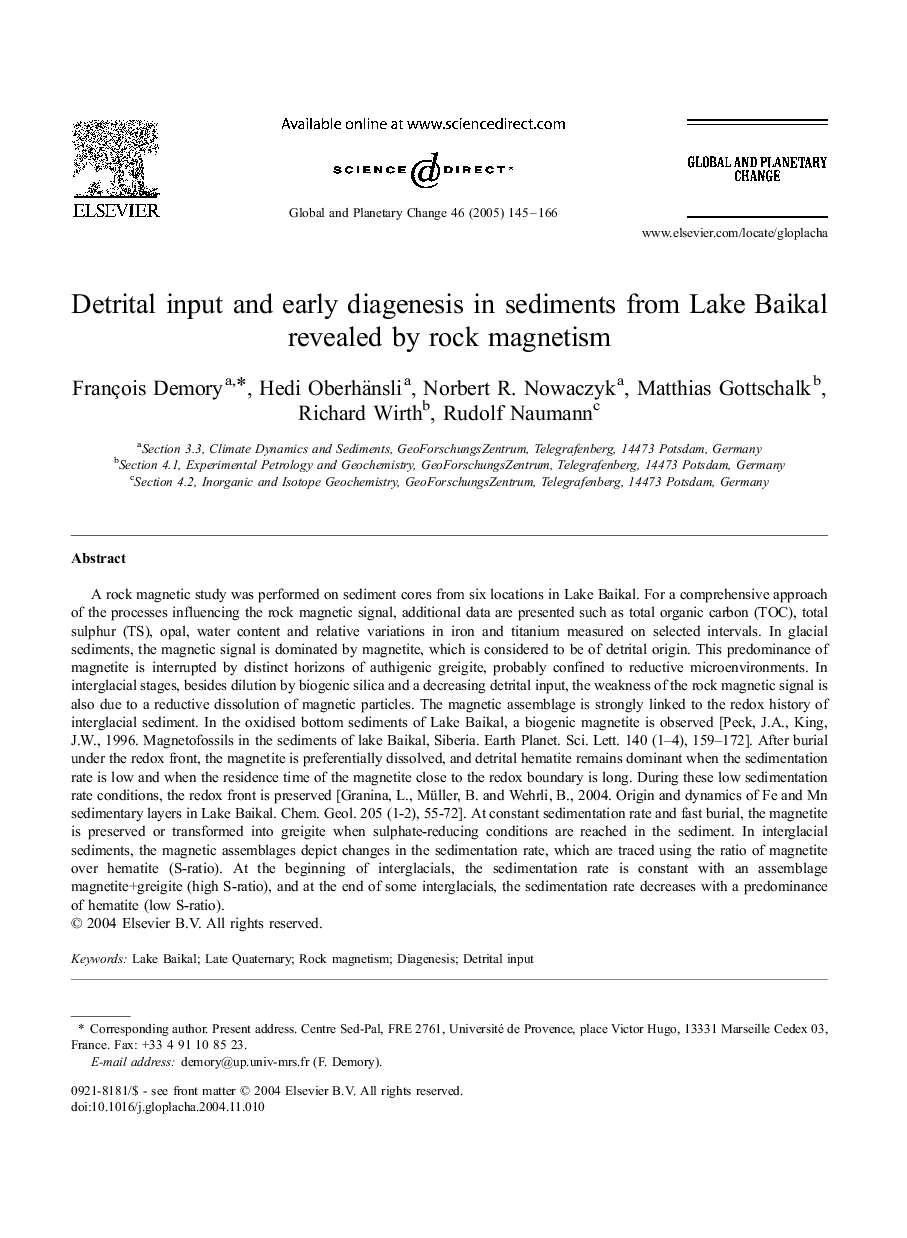| کد مقاله | کد نشریه | سال انتشار | مقاله انگلیسی | نسخه تمام متن |
|---|---|---|---|---|
| 9462401 | 1621745 | 2005 | 22 صفحه PDF | دانلود رایگان |
عنوان انگلیسی مقاله ISI
Detrital input and early diagenesis in sediments from Lake Baikal revealed by rock magnetism
دانلود مقاله + سفارش ترجمه
دانلود مقاله ISI انگلیسی
رایگان برای ایرانیان
کلمات کلیدی
موضوعات مرتبط
مهندسی و علوم پایه
علوم زمین و سیارات
فرآیندهای سطح زمین
پیش نمایش صفحه اول مقاله

چکیده انگلیسی
A rock magnetic study was performed on sediment cores from six locations in Lake Baikal. For a comprehensive approach of the processes influencing the rock magnetic signal, additional data are presented such as total organic carbon (TOC), total sulphur (TS), opal, water content and relative variations in iron and titanium measured on selected intervals. In glacial sediments, the magnetic signal is dominated by magnetite, which is considered to be of detrital origin. This predominance of magnetite is interrupted by distinct horizons of authigenic greigite, probably confined to reductive microenvironments. In interglacial stages, besides dilution by biogenic silica and a decreasing detrital input, the weakness of the rock magnetic signal is also due to a reductive dissolution of magnetic particles. The magnetic assemblage is strongly linked to the redox history of interglacial sediment. In the oxidised bottom sediments of Lake Baikal, a biogenic magnetite is observed [Peck, J.A., King, J.W., 1996. Magnetofossils in the sediments of lake Baikal, Siberia. Earth Planet. Sci. Lett. 140 (1-4), 159-172]. After burial under the redox front, the magnetite is preferentially dissolved, and detrital hematite remains dominant when the sedimentation rate is low and when the residence time of the magnetite close to the redox boundary is long. During these low sedimentation rate conditions, the redox front is preserved [Granina, L., Müller, B. and Wehrli, B., 2004. Origin and dynamics of Fe and Mn sedimentary layers in Lake Baikal. Chem. Geol. 205 (1-2), 55-72]. At constant sedimentation rate and fast burial, the magnetite is preserved or transformed into greigite when sulphate-reducing conditions are reached in the sediment. In interglacial sediments, the magnetic assemblages depict changes in the sedimentation rate, which are traced using the ratio of magnetite over hematite (S-ratio). At the beginning of interglacials, the sedimentation rate is constant with an assemblage magnetite+greigite (high S-ratio), and at the end of some interglacials, the sedimentation rate decreases with a predominance of hematite (low S-ratio).
ناشر
Database: Elsevier - ScienceDirect (ساینس دایرکت)
Journal: Global and Planetary Change - Volume 46, Issues 1â4, April 2005, Pages 145-166
Journal: Global and Planetary Change - Volume 46, Issues 1â4, April 2005, Pages 145-166
نویسندگان
François Demory, Hedi Oberhänsli, Norbert R. Nowaczyk, Matthias Gottschalk, Richard Wirth, Rudolf Naumann,